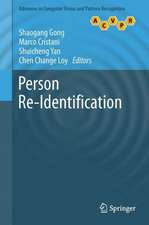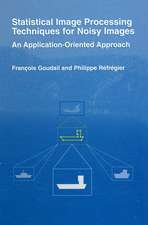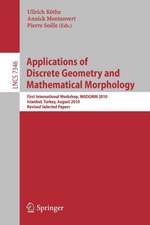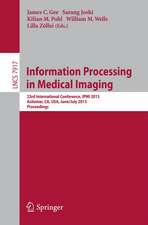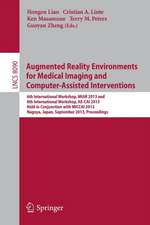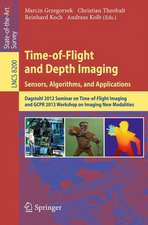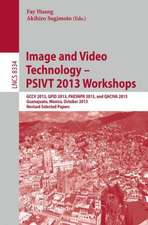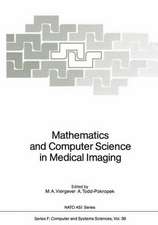Pathological Brain Detection: Brain Informatics and Health
Autor Shui-Hua Wang, Yu-Dong Zhang, Zhengchao Dong, Preetha Phillipsen Limba Engleză Paperback – 19 ian 2019
| Toate formatele și edițiile | Preț | Express |
|---|---|---|
| Paperback (1) | 329.76 lei 6-8 săpt. | |
| Springer Nature Singapore – 19 ian 2019 | 329.76 lei 6-8 săpt. | |
| Hardback (1) | 336.02 lei 6-8 săpt. | |
| Springer Nature Singapore – 31 iul 2018 | 336.02 lei 6-8 săpt. |
Preț: 329.76 lei
Preț vechi: 412.21 lei
-20% Nou
Puncte Express: 495
Preț estimativ în valută:
63.10€ • 67.48$ • 52.61£
63.10€ • 67.48$ • 52.61£
Carte tipărită la comandă
Livrare economică 18 aprilie-02 mai
Preluare comenzi: 021 569.72.76
Specificații
ISBN-13: 9789811338342
ISBN-10: 9811338345
Pagini: 242
Ilustrații: XXVI, 214 p.
Dimensiuni: 155 x 235 x 13 mm
Greutate: 0.35 kg
Ediția:Softcover reprint of the original 1st ed. 2018
Editura: Springer Nature Singapore
Colecția Springer
Seria Brain Informatics and Health
Locul publicării:Singapore, Singapore
ISBN-10: 9811338345
Pagini: 242
Ilustrații: XXVI, 214 p.
Dimensiuni: 155 x 235 x 13 mm
Greutate: 0.35 kg
Ediția:Softcover reprint of the original 1st ed. 2018
Editura: Springer Nature Singapore
Colecția Springer
Seria Brain Informatics and Health
Locul publicării:Singapore, Singapore
Cuprins
1 Basics of Pathological Brain Detection (PBD).- 2 Neuroimaging Modalities: Strengths and Weaknesses.- 3 Image Preprocessing for Pathological Brain Detection: A Summary.- 4 Canonical Feature Extraction Methods for Structural Magnetic Resonance Imaging.- 5 Multi-scale and Multi-resolution Features for Structural Magnetic Resonance Imaging.- 6 Dimensionality Reduction of Brain Image Features.- 7 Classification Methods for Pathological Brain Detection.- 8 Weight Optimization of Classifiers for Pathological Brain Detection.- 9 Comparison of Current PBD Systems.
Notă biografică
Dr. Shui-Hua Wang received her B.S. degree from Southeast University in 2008 and an M.S. from the City University of New York in 2012. She received her Ph.D. from Nanjing University in 2016. She is currently an assistant professor at Nanjing Normal University, and a visiting researcher in University of Leicester, UK. She serves as the editor of Journal of Alzheimer’s disease. In the past, she served as the guest lead editor of International Journal of Biomedical Imaging and Multimedia Tools and Application.
Prof. Dr. Yu-Dong Zhang received his B.S. and M.S. degrees from Nanjing University of Aeronautics and Astronautics in 2004 and 2007. He received his Ph.D. degree in Signal and Information Processing from Southeast University in 2010. From 2010 to 2012, he worked at Columbia University as a postdoc. From 2012 to 2013, he worked as a research scientist at Columbia University and New York State Psychiatric Institute. From 2013 to 2017, heworked as a full professor and doctoral advisor at School of computer science and technology at Nanjing Normal University. From 2018, he is a full Professor in Department of Informatics, University of Leicester, UK. His research interests include biomedical image processing, pattern recognition, and artificial intelligence.
Prof. Dr. Zhengchao Dong is a former Associate Professor of Translational Imaging at Columbia University, USA. Having also served at New York State Psychiatry Institute, USA, he has published over 20 papers on JAMA Psychiatry, Progress in Nuclear Magnetic Resonance Spectroscopy, Neuropsychopharmacology, Neuroimages, Human Brain Mapping, etc.
Preetha Phillips is currently pursuing her Doctor of Osteopathic Medicine degree at West Virginia School of Osteopathic Medicine. She received her B.S. degree from Shepherd University in May 2016. She has conducted research on using magnetic resonance spectroscopy (MRS)to diagnose panic disorder, and on the analysis of pain mechanisms in rats.
Prof. Dr. Yu-Dong Zhang received his B.S. and M.S. degrees from Nanjing University of Aeronautics and Astronautics in 2004 and 2007. He received his Ph.D. degree in Signal and Information Processing from Southeast University in 2010. From 2010 to 2012, he worked at Columbia University as a postdoc. From 2012 to 2013, he worked as a research scientist at Columbia University and New York State Psychiatric Institute. From 2013 to 2017, heworked as a full professor and doctoral advisor at School of computer science and technology at Nanjing Normal University. From 2018, he is a full Professor in Department of Informatics, University of Leicester, UK. His research interests include biomedical image processing, pattern recognition, and artificial intelligence.
Prof. Dr. Zhengchao Dong is a former Associate Professor of Translational Imaging at Columbia University, USA. Having also served at New York State Psychiatry Institute, USA, he has published over 20 papers on JAMA Psychiatry, Progress in Nuclear Magnetic Resonance Spectroscopy, Neuropsychopharmacology, Neuroimages, Human Brain Mapping, etc.
Preetha Phillips is currently pursuing her Doctor of Osteopathic Medicine degree at West Virginia School of Osteopathic Medicine. She received her B.S. degree from Shepherd University in May 2016. She has conducted research on using magnetic resonance spectroscopy (MRS)to diagnose panic disorder, and on the analysis of pain mechanisms in rats.
Textul de pe ultima copertă
This book provides detailed practical guidelines on how to develop an efficient pathological brain detection system, reflecting the latest advances in the computer-aided diagnosis of structural magnetic resonance brain images. Matlab codes are provided for most of the functions described. In addition, the book equips readers to easily develop the pathological brain detection system further on their own and apply the technologies to other research fields, such as Alzheimer’s detection, multiple sclerosis detection, etc.
Caracteristici
Illustrates the complete process of developing a pathological brain detection system Provides Matlab codes and Functions for most functions Summarizes and reviews the state-of-the-art in the field of pathological brain detection






